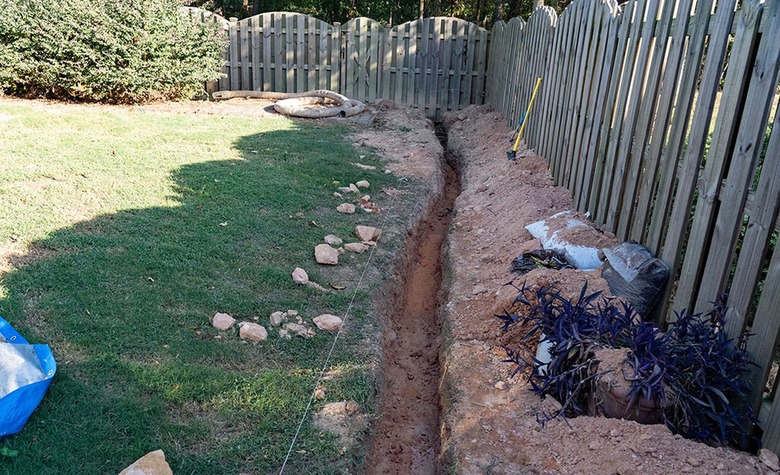Problems With French Drains
We may receive a commission on purchases made from links.
A French drain, also called a land drain, is made up of a ditch filled with stones or gravel. The ditch directs water away from an undesirable area, such as the base of your house to keep those vulnerable areas dry. French drains can be a simple and useful way to redirect water on a property, as long as they're angled from high to low ground. However, French drains also have a number of disadvantages to consider to avoid problems.
Potential Clogging Issues
Potential Clogging Issues
Water seeping through the soil to reach a French drain often carries sediment into the drain. The water then deposits this sediment on the gravel in the drain as it flows through the ditch. Muddy water flowing through the drain can also cause clogs, and roots from nearby plants can get into the drain and block it. Over time, this sediment build-up can slow the flow of water through the drain or block it up entirely.
Once this occurs, the water no longer passes through the drain correctly and can flood your home or other areas of your property. Repairing this problem often requires digging up the entire drain and replacing the gravel. Some French drain installations attempt to avoid this problem by using a filter at the beginning of the drain. When it clogs, only the filter must be replaced.
Difficulty of Installation
Difficulty of Installation
The French drain installation process can be complicated. Some French drains are built along with the house, but most are installed after home construction, usually in response to a wet basement or other problem. This requires digging down to the level of the footer outside the home and may require the homeowner to remove shrubs, decks, porches, and other structures.
While you dig, you may encounter gas and water lines, electrical wires, and sewer pipes, all of which pose hazards. It's also important not to dig too deep. If the drain is dug below the level of the footer, it may undermine the foundation, causing the home to settle. Another consideration is the slope of the drain, which should drop about 1 inch for every 8 feet in the pipe length. If you don't get the slope correct during the installation process, the drain can't move the water away from your home properly.
Addition of Sump Pumps
Addition of Sump Pumps
French drains installed inside the home to reduce flooding require a sump pump to operate correctly. The sump pump moves the water outside and into the drain. Unfortunately, a pump adds to the cost of installation, and many lower-end pumps have a short lifespan. Pumps installed without a battery backup will not function during a power outage, which often leaves you vulnerable in a storm when the risks of flooding are higher..
Backflow in French Drains
Backflow in French Drains
In areas with poorly draining soils, draining water from a French drain into the traditional dry well may cause problems. When the soil becomes saturated, the well fills with water, sending flow back up the French drain and into the home or original problem area. In these cases, it may be necessary to direct the drain into street storm drains or another area. Many homeowners choose to tie their French drains into a downspout, but as the house settles over the years, this method may cease to work, causing water to flow back into the home.
